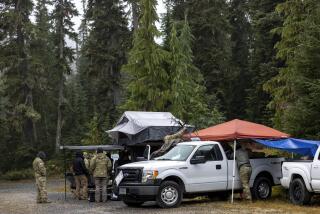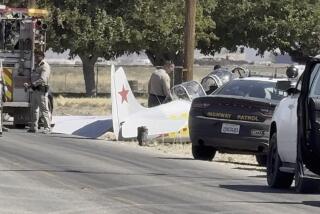4 Die in Collision of Air Force Jet With Civilian Plane Near Tehachapi
TEHACHAPI â A U.S. Air Force jet collided with a single-engine civilian plane over rugged canyon country Friday morning, killing the four occupants of both planes.
Authorities said the collision occurred just after 11 a.m., scattering debris into an area known as Cameron Canyon. The Air Force plane, a T-38 Talon training jet, was flying a test mission out of nearby Edwards Air Force Base. The civilian plane was believed to be on a commercial flight, taking aerial photographs.
Skies were clear at the time of the crash, and flying conditions were described by the Air Force as ideal.
Identify Officers
An Air Force spokesman identified the two officers as Maj. Michael J. Keane, 33, of Mt. Prospect, Ill., and 1st Lt. Gregory B. Hoglan, 26, of University City, Mo. Keane, unmarried, had been a member of the 6512 Test Squadron at Edwards since January, while Hoglan, who leaves a wife and two infant children, had been an avionics engineer with the 6502 Test Group at Edwards since January, 1984.
Late Friday authorities at the Federal Aviation Administration said they were still trying to identify the occupants of the civilian aircraft.
However, the FAA identified the civilian aircraft as a Cessna 206 registered to Pacific Aerographics of Santa Ana, a family owned firm that uses small aircraft to take aerial photographs. Late Friday, a friend of the family told The Times that the companyâs owner, Marvin (Andy) Andelin, apparently was the pilot of the civilian plane. He had no information on the identity of the passenger, a camera operator, in the aircraft. Spokesmen for Pacific Aerographics declined to comment.
According to Air Force officials the collision occurred within a Military Operations Area used for test flights out of Edwards AFB. They said the area was not barred to civilian flights although some restrictions might apply. Both planes were operating under visual flight rules at the time of the crash.
At Edwards an Air Force spokesman said, âIt is our determination that no one was doing anything they shouldnât have been doing.â The spokesman noted, however, that a joint investigation with the FAA was begun Friday to determine the cause of the collision.
Immediately after the crash there were initial reports that a single parachute had been seen, but later in the day other eyewitnesses failed to confirm the sighting. Rescuers said four bodies were found at the crash site.
The area of the collision is steep brush country in the middle of the Tehachapi Mountains. Jay Portlock, a construction worker at a wind generating farm near Tehachapi, said he heard the crash, which he first thought was a sonic boom. Looking up, Portlock said he saw a cloud of smoke that he estimated was only 250 feet above the ground.
âThe military plane was in a flat spin coming down on fire,â Portlock said. âI could see that the nose was smashed where it must have hit the other plane.â He said the military plane fell out of sight behind a ridge.
One other eyewitness also saw the smoke cloud from the collision and similarly estimated the height at 250 feet above the level of the terrain, which is roughly at an altitude of 4,500 feet.
According to flight maps of the area, the Military Operation Area prohibits military planes from flying lower than 1,200 feet above ground level. However, the flight maps also designate special zones, known as visual routes, that allow military flights to fly at lower or higher altitudes than normally permitted. One such visual route appears to pass close to or directly over the impact area.
Don Hailey, a civilian spokesman for Edwards, said he believed the 250-foot estimate for the height of the collision was probably âvery inaccurate.â
âNormally we donât have flights at 250 feet above the ground,â said Hailey. âOnly when weâre testing terrain-following devices do we fly that low, and thatâs not what was happening today.â
Other Air Force officials said the T-38 was acting as a chase plane to a flight by an F-15 fighter. The purpose of the flight was to test radar, and the T-38 was posing as a target for the fighterâs radar tracking devices.
Pacific Aerographics, identified as the registered owner of the civilian plane, provides precision aerial photographs of terrain scheduled for commercial or industrial development. The photographs are taken with high-resolution cameras mounted in the belly of its two single-engine airplanes. Each plane requires a pilot and a camera operator.
In addition to developers, Pacific Aerographics has provided photographs for petroleum companies searching for likely oil formations and Thomas Bros. Maps, the Irvine company that makes map books for 28 counties.
Eric Malnic reported from Tehachapi and Robert A. Jones from Los Angeles. Times staff writer Bob Schwartz in Orange County contributed to this story.
More to Read
Sign up for Essential California
The most important California stories and recommendations in your inbox every morning.
You may occasionally receive promotional content from the Los Angeles Times.










